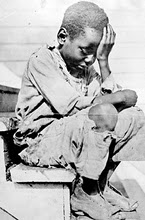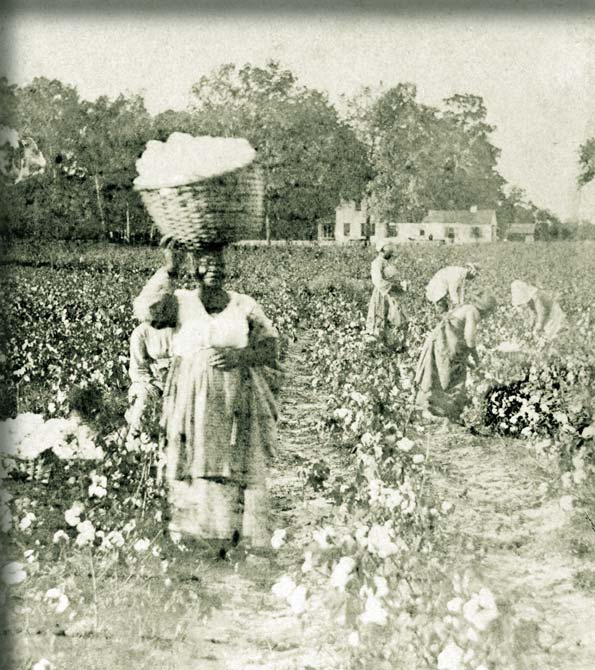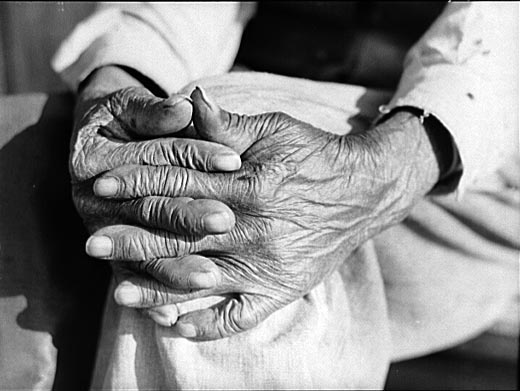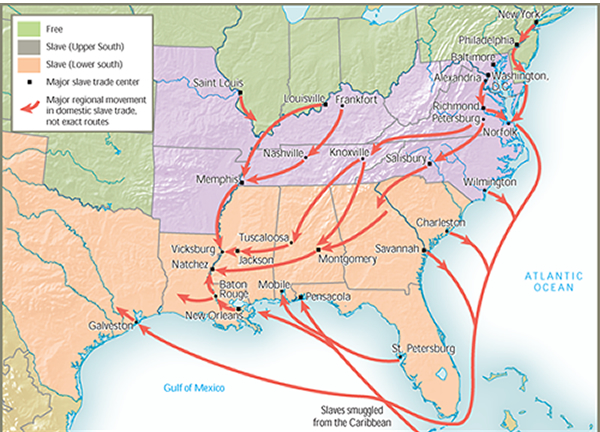SLAVE TRADE
The level of slave exports grew from about 36,000 a year during the early 18th century to almost 80,000 a year during the 1780s.
The Angolan region of west-central Africa made up slightly more than half of all Africans sent to the Americas and a quarter of imports to British North America.
Approximately 11,863,000 Africans were shipped across the Atlantic, with a death rate during the Middle Passage reducing this number by 10-20 percent.
As a result between 9.6 and 10.8 million Africans arrived in the Americas.
About 500,000 Africans were imported into what is now the U.S. between 1619 and 1807--or about 6 percent of all Africans forcibly imported into the Americas. About 70 percent arrived directly from Africa.
Well over 90 percent of African slaves were imported into the Caribbean and South America. Only about 6 percent of imports went directly to British North America. Yet by 1825, the U.S. had a quarter of blacks in the New World.
The majority of African slaves were brought to British North America between 1720 and 1780. (Average date of arrival for whites is 1890)

COMPARISONS
- American plantations were dwarfed by those in the West Indies. About a quarter of U.S. slaves lived on farms with 15 or fewer slaves. In 1850, just 125 plantations had over 250 slaves.
- In the Caribbean, Dutch Guiana and Brazil, the slave death rate was so high and the birth rate so low that they could not sustain their population without importations from Africa. Rates of natural decrease ran as high as 5 percent a year. While the death rate of U.S. slaves was about the same as that of Jamaican slaves, the fertility rate was more than 80 percent higher.
- U.S. slaves were further removed from Africa than those in the Caribbean. In the 19th century, the majority of slaves in the British Caribbean and Brazil were born in Africa. In contrast, by 1850, most U.S. slaves were third-, fourth-, or fifth generation Americans.

DEMOGRAPHY
- Slavery in the U.S. was distinctive in the near-balance of the sexes and the ability of the slave population to increase its numbers by natural reproduction.
- Unlike any other slave society, the U.S. had a high and sustained natural increase in the slave population for a more than a century and a half.
- In 1860, 89 percent of the nation's African Americans were slaves; blacks formed 13 percent of the country's population and 33 percent of the South's population.
- In 1860, less than 10 percent of the slave population was over 50 and only 3.5 percent was over 60.
- The average age of first birth for slave women was around 20. Child spacing averaged about 2 years.
- The average number of children born to a slave woman was 9.2--twice as many in the West Indies.
- Most slaves lived in nuclear households consisting of two parents and children: 64 percent nuclear; 21 percent single parents; 15 percent non-family.
- Mother-headed families were 50 percent more frequent on plantations with 15 or fewer slaves than on large ones. Smaller units also had a disproportionately large share of families in which the father and mother lived on different plantations for most of the week.
- Average number of persons per household was 6.
- Average age of women at birth of their first child was about 21.
- Few slaves lived into old age. Between 1830 and 1860, only 10 percent of slaves in North America were over 50 years old.

CHILDREN
- Most infants were weaned within three or four months
- There were few instances in which slave women were released from field work for extended periods during slavery. Even during the last week before childbirth, pregnant women on average picked three-quarters or more of the amount normal for women.
- Half of all slave babies died in the first year of life--twice the rate for white babies.
- The average birth weight of slave infants was less than 5.5 pounds.
- Slave children were tiny; their average height did not reach three feet until they were 4; they were 5.5 inches shorter than modern children and comparable to children in Bangladesh and the slums of Lagos.
- At 17, slave men were shorter than 96 percent of men today and slave women shorter than 80 percent of contemporary women.
- Slaves did not reach their full stature--67 inches for men and 62.5 inches for women--until their mid-20s.
- Children entered the labor force as early as 3 or 4. Some were taken into the master's house to be servants while others were assigned to special children's gangs called "trash gangs," which swept yards, cleared drying cornstalks from fields, chopped cotton, carried water to field hands, weeded, picked cotton, fed work animals, and drove cows to pasture.
- By age 7, over 40 percent of the boys and half the girls had entered the work force. At about 11, boys began to transfer to adult field jobs.

LABOR
- At the beginning of the 18th century, it was common for small groups of slaves to live and work by themselves on properties remote from their masters' homes.
- Sugar field workers in Jamaica worked about 4,000 hours a year--three times that of a modern factory worker. Cotton workers toiled about 3,000 hours a year.
- The median size of slaveholdings ranged from approximately 25 slaves in the tobacco regions of Maryland, Virginia, and North Carolina, to 30-50 slaves in upland cotton regions. Plantations in the Sea Islands of South Carolina and Georgia and the sugar parishes of Louisiana averaged 60-80 slaves. In small areas of Louisiana, Mississippi, and South Carolina, slaves lived on 125-175 person units.
- In 1790, 44 percent of enslaved Africans lived on units of 20 or more slaves. In 1860, the figure was 53 percent (and approximately a third lived on units with 50 or more slaves).
- Half of all masters owned five or fewer slaves. While most small slaveholders were farmers, a disproportionate share were artisans, shopkeepers, and public officials.

- Prices of slaves varied widely over time. During the 18th century, slave prices generally rose. Though they fell somewhat before the start of the revolution, by the early 1790s, even before the onset of cotton expansion, prices had returned to earlier levels. Prices rose to a high of about $1,250 during the cotton boom of the late 1830s, fell to below half that level in the 1840s, and rose to about $1,450 in the late 1850. Males were valued 10-20 percent more than females; at age ten, children's prices were about half that of a prime male field hand.
- By 1850, about 64 percent of slaves lived on cotton plantations; 12 percent raised tobacco, 5 percent sugar, 4 percent rice.
- Among slaves 16-20, about 83 percent of the males and 89 percent of the females were field hands. The remainder were managers, artisans, or domestic servants.
- Growing cotton required about 38 percent of the labor time of slaves; growing corn and caring for livestock 31 percent; and 31 percent improving land, constructing fences and buildings, raising other crops, and manufacturing products such as clothes.
- Slaves constructed more than 9,500 miles of railroad track by 1860, a third of the nation's total and more than the mileage of Britain, France, and Germany.
- About 2/3s of slaves were in the labor force, twice the proportion among free persons. Nearly a third of slave laborers were children and an eighth were elderly or crippled.

DISEASE
- Slaves suffered a variety of maladies--such as blindness, abdominal swelling, bowed legs, skin lesions, and convulsions--that may have been caused by beriberi (caused by a deficiency of thiamine), pellagra (caused by a niacin deficiency), tetany (caused by deficiencies of calcium, magnesium, and Vitamin D), rickets (also caused by a deficiency of Vitamin D), and kwashiorkor (caused by severe protein deficiency).
- Diarrhea, dysentery, whooping cough, and respiratory diseases as well as worms pushed the infant and early childhood death rate of slaves to twice that experienced by white infants and children.

DOMESTIC SLAVE TRADE
- Between 1790 and 1860, 835,000 slaves were moved from Maryland, Virginia, and the Carolinas to Alabama, Mississippi, Louisiana, and Texas.
- Between 16 and 60 percent of slaves were shipped west by traders.

PROFITABILITY
- Slaveholding became more concentrated over time. The fraction of households owning slaves fell from 36 percent in 1830 to 25 percent in 1860.
- The distribution of wealth in the South was much more unequal than that of the North.
- Nearly 2 of 3 males with estates of $100,000 or more lived in the South in 1860.
- If the North and South are treated as separate nations, the South was the fourth most prosperous nation in the world in 1860. Italy did not achieve the southern level of per capita income until the eve of World War II.
- Civil War During the Civil War, 140,500 freed slaves and 38,500 free blacks served in the Union Army.

Trails of Tears 😪
ReplyDeleteTrails of Tears 😪
ReplyDeleteTrails of Tears
ReplyDelete"Vengeance is mine, saith the Lord" I'm thinking there's a lot of people in Hell right now, they earned a one way ticket.
ReplyDelete